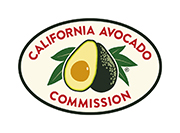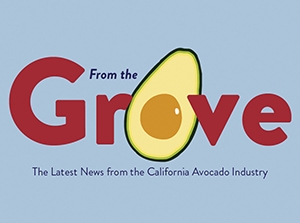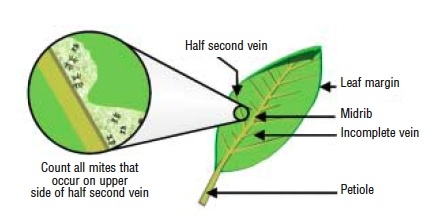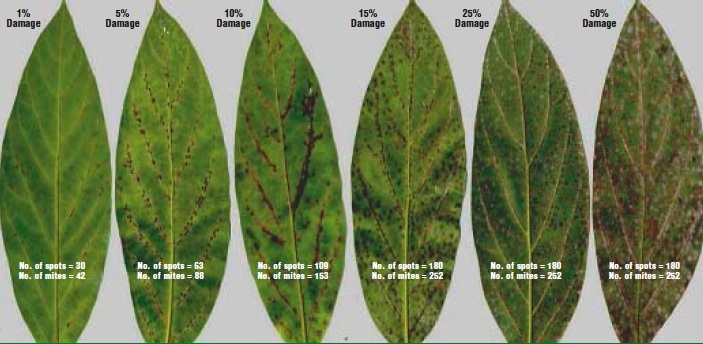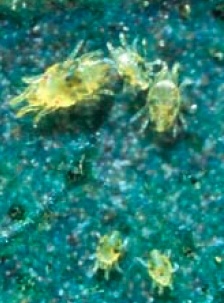Avocado Persea Mite Pest Management
Persea mites damage avocado trees by removing chlorophyll from the leaves when feeding. As a result, once 7.5-10% of the leaf surface is damaged, the leaves begin to drop. Because healthy leaves are critical to a healthy avocado tree and crop, persea mite damage can effect avocado growers’ profitability.
Estimating the number of persea mites in the avocado grove
It is best to consult a Pest Control Advisor (PCA) when planning avocado grove pest management strategies. In general, PCAs recommend persea mite spray treatments when sampling indicates there are 70-100 persea mites per leaf. To calculate the number of persea mites, count the number of motile mites infesting the half second vein (see photo). Take the average number of mites counted on 10 randomly selected leaves and multiply this by a correlation factor (=12) for an estimate of the number of persea mites per leaf. To estimate the number of leaves infested with persea mites, choose 50 random leaves from several trees and calculate the percentage infestation by multiplying the total number of leaves with one or more motile persea mites by two (e.g., 15 infested leaves out of 50 is 30% leaf infestation).
Persea mite pest management
- Research shows that heat waves and a declining food supply are the most prominent means of persea mite mortality. In general, persea mite populations go into rapid decline at the end of the summer.
- Heat waves (several consecutive days with temperatures exceeding 100 F accompanied with low humidity < 50%) kill immature and adult persea mites. Orchards that are 20+ miles inland have less persea mite infestations because the groves have consistently higher temperatures and lower humidity.
- A lack of healthy undamaged avocado leaves leads to a decline in persea mites.
- As persea mite populations increase and the number of healthy avocado leaves decrease, persea mites migrate by using silk strands that act as sails or balloons.
- The population of the Euseius hibisci, naturally occurring predatory mite, builds up over the summer and can help control the persea mite population in late summer. PCAs recommend using Galendromus helveolus and Neoseiulus californicus as natural predators. N. californicus is recommended because this predator costs less and leaves suffer less persea mite feeding damage when N. californicus is used.
- N. californicus can be released manually into the grove. The predator will not spread from one central points, so small paper cups containing the predators should be attached to the branches of each avocado tree. In order for the predators to be effective, a minimum of 2000 predators per 15 foot avocado tree must be released.
- Predatory releases should be made when 50% of sampled leaves have one or more motile persea mites on them. If releases are made too early (i.e., at 25% leaf infestation) there is not enough food for predators to establish. If releases are made too late (i.e., at 95% leaf infestation) persea mite numbers are too high for the predators to control.
- A second release of predators can be made when 75% of sampled leaves have more than one motile persea mite.
- N. californicus does not appear to over-winter in large numbers in California avocado orchards and predator releases need to be made each year.
- Some PCAs have reported good control of persea mite by making releases of N. californicus or G. helveolus at a rate of 5000 per acre. PCAs make predator mite releases by spritzing infested leaves with water. A small amount of corn grits with predators is then sprinkled onto the dampened leaf. The water traps the grits with predators. As the water dries the predators free themselves and commence searching for prey. Every tree in an infested block is treated in this manner.
Insecticides for persea mites
A PCA will provide the best recommendation concerning pesticides for persea mites.
Remove alternate persea mite host plants
Persea mites also thrive on a range of other fruit, ornamental, and weed plants. Removal of these hosts plants can help prevent large populations of persea mites from building.
- Thompson and Flame seedless grapes
- Apricots, peaches, plums and nectarines
- Persimmons
- Milkweed
- Sow thistle
- Lamb’s quarters
- Sumac
- Carob
- Camphor
- Roses
- Acacias
- Annatto
- Willows
- Bamboo
